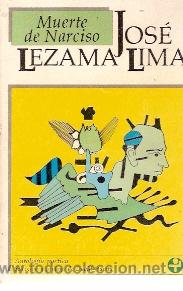4.1.2.2.1 Death of Narcissus (1937), first poetic text by José Lezama Lima (1910 – 1976)

In “Muerte de Narciso” we can already see the seeds of practically all the elements that would take shape in Lezamian’s unique poetics, but the book itself is already a magnificent concretization of his poetic vocation, written from a different dimension of time, perhaps an oasis of timelessness that seeks to anchor itself in a future that is seen as certain but from a tradition that has José Martí as its main support.
Regarding the book’s initial impact, Cintio Vitier says, “When a booklet entitled ‘Death of Narcissus’ appeared in Havana in 1937, very few, perhaps only a few young people and adolescents, suspected what this poetic discourse, so difficult to relate to what was happening at that time in the country’s daily, political, and literary life, would mean over the years. Time, fabulously invoked from the first line of that poem (“Danae weaves golden time along the Nile”), was to be the main ally of a word that, despite its ahistorical appearance, was immersed in the profound evolution that feeds history.”
This first poem is precisely the one that gives title to the entire composition and where its firm foundation in a poetic and mythical tradition with multiple references is already evident, especially Greek culture and later, it will be seen that it also has an eminently Catholic symbolism that surpasses that cosmogony.
In the collection of poems, one can already appreciate what might be called a refoundation of the Island through its definitive symbolic incorporation into the heritage of ecumenical culture, in which the holistic fusion of elements from diverse literary currents, among them purism, is also notable, in order to delve into the unknown, all of which results in a collection of poems that extends the significant field of culture as a replacement for the historical void, with procedures that lead to considering essential in the text a “rapid falconry of metaphors,” as Ángel Gaztelu says.
The text is imbued with a sensuality of delight in the words that sometimes derives in visual sensation, in addition to the use of a vocabulary of high culture and in a general sense it supposes a break with the traditional aesthetic conceptions to create a different beauty, which is not emanated from the object but sufficiency in itself, all of which hindered the reception by the public and critics, with the exception of the enlightened Origenists.
Already from this text, Lezama tries to fill the void that discourages reality through the exuberance of the image, in a hypertelic sense, not recreating but creating a reality as valid as the one that transpires around him, from which he does not divorce himself but which he does not intend to copy but rather to postulate another possibility, almost like a poetic country that would ultimately have its influence on reality, in the manner of Borgesian fiction.








